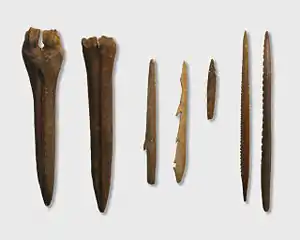Kunda culture
The Kunda culture, originating from the Swiderian culture, comprised mesolithic hunter-gatherer communities of the Baltic forest zone extending eastwards through Latvia into northern Russia, dating to the period 8500–5000 BC according to calibrated radiocarbon dating. It is named after the Estonian town of Kunda, about 110 kilometres (70 mi) east of Tallinn along the Gulf of Finland, near where the first extensively studied settlement was discovered on Lammasmäe Hill and in the surrounding peat bog.[1] The oldest known settlement of the Kunda culture in Estonia is Pulli. The Kunda culture was succeeded by the Narva culture, who used pottery and showed some traces of food production.
| Geographical range | Europe |
|---|---|
| Period | Mesolithic Europe |
| Dates | c. 8500– c. 5000 BC |
| Type site | Kunda, Estonia |
| Major sites | Pulli settlement |
| Preceded by | Swiderian culture |
| Followed by | Narva culture |
| The Mesolithic |
|---|
| ↑ Upper Paleolithic |
|
| ↓ Neolithic |
Culture

Most Kunda settlements are located near the edge of the forests beside rivers, lakes, or marshes. Elk were extensively hunted, perhaps helped by trained domestic hunting-dogs. On the coast seal hunting is represented. Pike and other fish were taken from the rivers. There is a rich bone and antler industry, especially in relation to fishing gear. Tools were decorated with simple geometric designs, lacking the complexity of the contemporary Maglemosian Culture communities to the southwest.
Origin of culture
The Kunda culture appears to have undergone a transition from the Palaeolithic Swiderian culture located previously over much of the same range. One such transition settlement, Pasieniai 1C in Lithuania, features stone tools of both Late Swiderian and early Kunda. One shape manufactured in both cultures is the retouched tanged point. The final Swiderian is dated 7800–7600 BC by calibrated radiocarbon dating, which is in the Preboreal period, at the end of which time with no gap the early Kunda begins. Evidently the descendants of the Swiderians were the first to settle Estonia when it became habitable. Other post-Swiderian groups extended as far east as the Ural mountains.[2]
Genetics
Jones et al. (2017) determined that peoples of the Kunda culture and the succeeding Narva culture showed closer genetic affinity with Western Hunter-Gatherers (WHGs) than Eastern Hunter-Gatherers (EHGs).[3]
Mittnik et al. (2018) analyzed the remains of a male and female ascribed to the Kunda culture. They found the male to be carrying haplogroup I and U5b2c1, while the female carried U4a2. They were found to have "a very close affinity" with WHGs, although with "a significant contribution" from Ancient North Eurasians (ANE). Their ANE ancestry was lower than that of Scandinavian Hunter-Gatherers, indicating that ANE ancestry entered Scandinavia without traversing the Baltic.[4]
Matthieson et al. (2018) analyzed a large number of individuals buried at the Zvejnieki burial ground, most of whom were affiliated with the Kunda culture and the succeeding Narva culture. The mtDNA extracted belonged exclusively to haplotypes of U5, U4 and U2. With regards to Y-DNA, the vast majority of samples belonged to R1b1a1a haplotypes and I2a1 haplotypes. The results affirmed that the Kunda and Narva cultures were about 70% WHG and 30% EHG. The nearby contemporary Pit–Comb Ware culture was on the contrary found to be about 65% EHG.[5]
Locations of sites
- Kunda, Estonia
- Pulli, Estonia
- Luga
- Pasieniai, Lithuania
- Ristola, Finland
- Velizh
- Zvejnieki, Latvia
References
- Shaw, Ian; Jameson, Robert, eds. (1999). A Dictionary of Archaeology. Blackwell Publishing. p. 346. ISBN 0-631-23583-3.
- Šatavičius, Egidijus (2005). "Swiderian Culture in Lithuania". Lietuvos archeologija. 29. ISSN 0207-8694.
- Jones 2017.
- Mittnik 2018.
- Mathieson 2018.
Sources
- Jones, Eppie R. (February 20, 2017). "The Neolithic Transition in the Baltic Was Not Driven by Admixture with Early European Farmers". Current Biology. Cell Press. 27 (4): 576–582. doi:10.1016/j.cub.2016.12.060. PMC 5321670. PMID 28162894.
- Mathieson, Iain (February 21, 2018). "The Genomic History of Southeastern Europe". Nature. Nature Research. 555 (7695): 197–203. Bibcode:2018Natur.555..197M. doi:10.1038/nature25778. PMC 6091220. PMID 29466330.
- Mittnik, Alisa (January 30, 2018). "The genetic prehistory of the Baltic Sea region". Nature Communications. Nature Research. 16 (1): 442. doi:10.1038/s41467-018-02825-9. PMC 5789860. PMID 29382937.